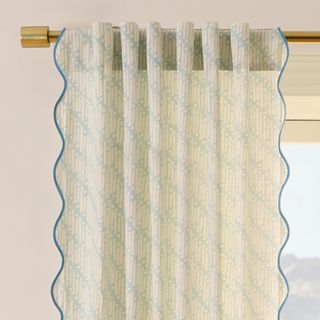25 beautiful window treatment ideas to elevate any room
Don't leave your window treatments to last, they are just as key to a room's scheme as colors, layouts and lighting
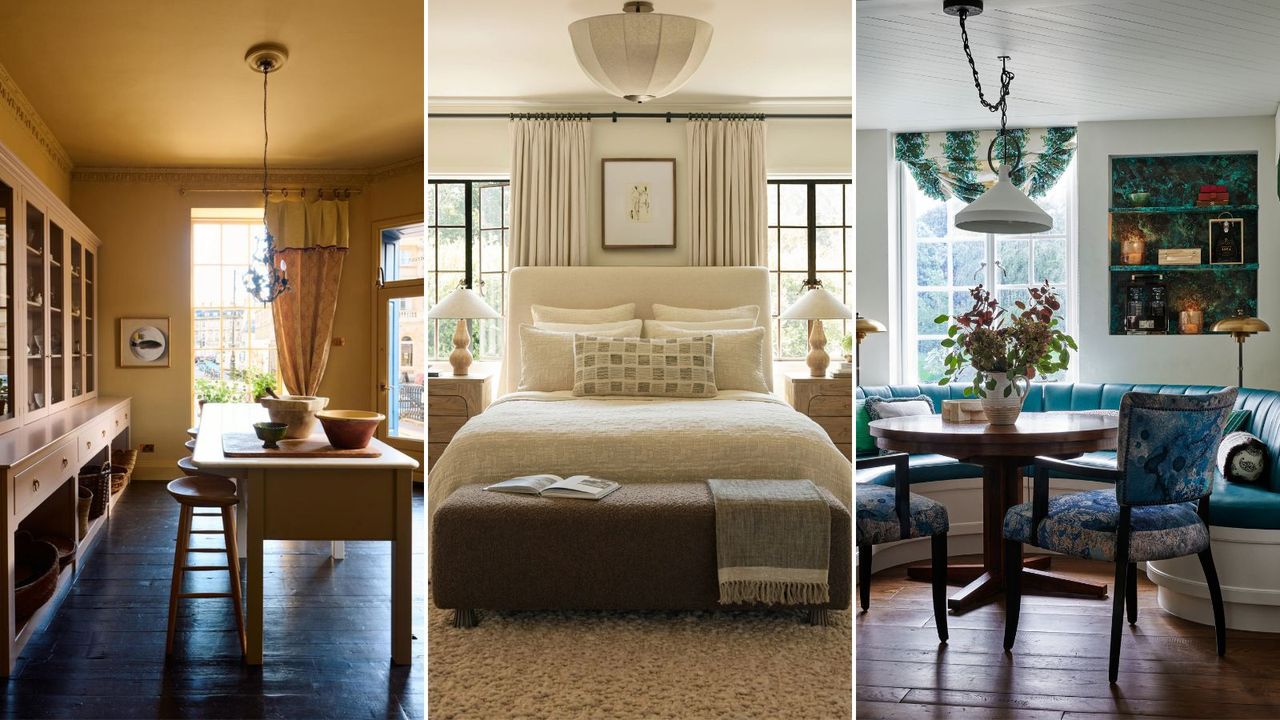
- 1. Choose colors wisely
- 2. Work with the room proportions you have
- 3. Choose the right fabric and drape
- 4. Go custom for the perfect curtains
- 5. Embrace the trend for Austrian blinds
- 6. Make smaller windows look larger
- 7. Create a seamless look with a single rail
- 8. Use just one panel for smaller windows
- 9. Create a focal point by framing the window
- 10. Create the illusion of ceiling height
- 11. Pattern match with upholstery or wallpaper
- 12. Or choose a decorative blind to add color and pattern
- 13. Create a cocooning look by going wall-to-wall
- 14. Use shutters for privacy, shade – and color
- 15. Create a seamless look on larger windows
- 16. Choose full length curtains for a traditional look
- 17. Use soft blinds in the bathroom
- 18. Pick natural materials like linen for a relaxed appeal
- 19. Try a warm shade in a cool room
- 20. Embrace the ruffle trend with a relaxed Roman blind
- 21. Balance light and privacy with a Venetian blind
- 22. Layer with a valance to create a statement
- 23. Pick solar shades for bright rooms
- 24. Tackle a corner window cleverly with curtains
- 25. Try on-trend vintage-inspired cafe curtains
We are all guilty of leaving window treatment ideas to the final stage of designing a room. They are seen as an addition, a finishing touch, something to consider once all the big choices are out of the way like colors, and furniture, and layouts. But think about how dominant your windows are in a room – they can often be the biggest feature of a room. And therefore the way you dress the windows can become on of the biggest features of a room too.
It therefore pays to pay more attention to your window treatment ideas, be considering them alongside all the first design decisions you make. Window dressings can change the vibe of the room, be an easy way to bring in color, pattern, mix styles, not to mention all the practical elements you can tick off (soundproofing, privacy, climate control, to name a few).
But where do you start when choosing a window treatment idea with countless options available? We asked interior designer for their top tips and what their favorite go-to window treatments are to provide you with some inspiration.
26 inspiring window treatment ideas for your home
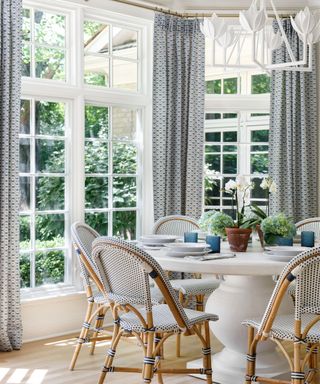
There are rules to follow to help you get window dressing ideas just right. From ceiling height to dealing with color and pattern and the big question – do you let them drape? We’ve pulled together a range of decorating ideas for window treatments, with expert tips on how to deal with the most common issues so you can make your entire home feel well-dressed.
1. Choose colors wisely

Choosing the right colors for your window treatments is a great first step in achieving the desired look and feel of a room. When selecting colors for window treatments, it's essential to consider the room's existing room color ideas, as well as the feeling that different hues convey.
Neutral tones like whites, grays, and beiges are timeless and versatile, seamlessly blending with various design styles. They offer a clean, serene backdrop that can make a space feel larger and more open. Bold colors, on the other hand, can create a focal point and bring a sense of energy and vibrancy.
The easiest way to get the color right is to match to your existing scheme. If you love pattern, then why not have an armchair covered in the same design? Pattern drenching is a big trend this year and it ties in perfectly with more maximalist decor ideas.
2. Work with the room proportions you have
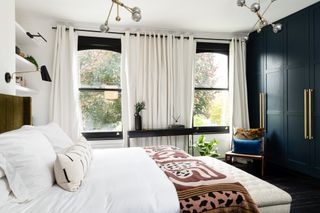
Understanding and working with the proportions of a room is essential when selecting window treatments – the right choice can accentuate architectural features, create a sense of balance, and even alter the perceived dimensions of a space.
‘Opt for floor-to-ceiling curtains, ensuring there are no gaps. This look adds height to a room, while keeping a clean and simple aesthetic. And attention to detail goes a long way, explains Jenna Choate and Mariana Ugarte from London-based Interior Fox.
‘For example, we like to swap out the eyelets to match the curtain pole. This simple but effective technique makes all the difference and helps to create a more unified and custom look.'
'Gone are the days of shorter curtains, they feel dated and can make a window feel small and boxed in. Instead, create a cohesive look by complementing the curtains with the wall color.’ The goal is to enhance the room's natural proportions rather than working against them.
3. Choose the right fabric and drape
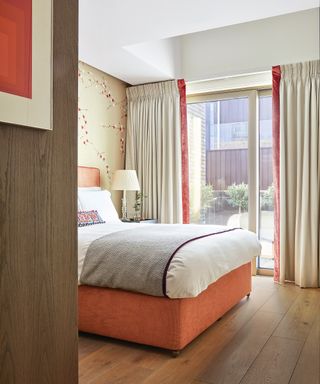
The fabric you choose can affect the amount of light that enters a room, the level of privacy, and the overall ambiance. Molly Freshwater, Creative Director at Secret Linen Store explains what she looks for when it comes to choosing the right fabric and drape:
‘I always think of window dressing as the final finishing touch to your room. The color is important, but for me, the fabric and drape is at the top of my curtain list to get right. My first rule of curtains is that they should be long to the floor and in the case of 100% linen curtains, even longer.'
'If it’s an airy, bright feel that you want in the room, it has to be 100% linen. These curtains let the light dapple through and give you privacy at the same time. They can be drawn back to almost nothing during the day, and if you want to tie them they are so light, you need only use a lovely ribbon.'
'If you need to keep the light out completely, a blind behind the linen will do this job and leave your room looking light and airy as and when you want it.’
We explore should curtains touch the floor in our dedicated feature.
4. Go custom for the perfect curtains
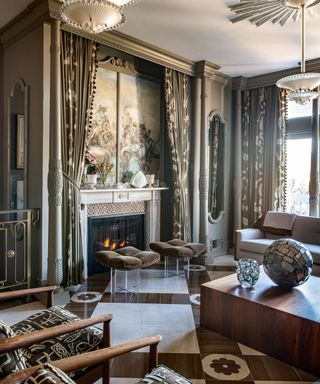
The drapes are the focal point of this room designed by James Yarosh Associates adding a softness as well as elegance to this luxurious living room. You can find so many gorgeous drapes in stores, however, when you want something truly special, James recommends going bespoke.
'When sourcing drapery, I generally visit my favorite fabric houses such as Clarence House, Dedar, Fortuny, Jean Monro, and Scalamandre, and make selections from there. However, when I can’t find an existing fabric that is right for the project, I turn to the garment industry and create a custom print,' he explains.
'For the drapery in my own living room, I went to the garment industry and enlisted an old haunt that created a custom color silk print modeled after an Oscar de la Renta scarf. The result is a beautiful art deco pattern with plumes of circles. We elevated it even further with a custom Scalamandre trim and matching tassels. To cover the minimum yardage the store required for custom fabric, I was also able to dress the fireplace next to the windows to add further luxury to the room and blur aesthetic timelines.'
5. Embrace the trend for Austrian blinds
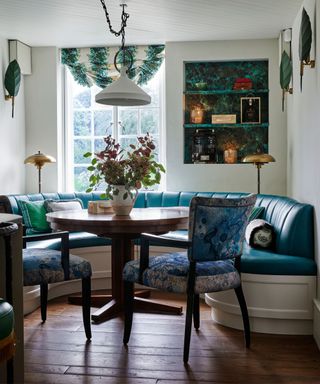
Austrian blinds are often associated with very traditional, old-fashioned, let's just say it, outdated spaces. But these ruched blinds are making a big comeback in 2025 and despite their dramatic look, they can work with many styles, not just in traditional homes.
You can go as voluminous as you like depending on the room and the style you want to create. But bear in mind you can choose a more... low key style, that adds all the softness you get from an Austrian blind but isn't as statement. This is a great choice for more practical spaces like kitchens and dining rooms.
6. Make smaller windows look larger
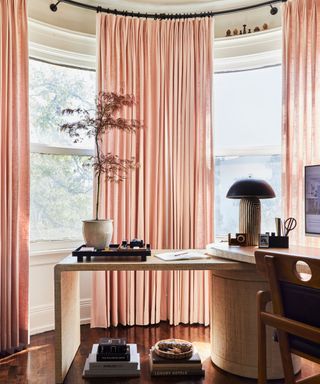
This is a great hack for making your windows look more expensive. If you are choosing curtains as your window treatment, don't just measure for the size of the windows themselves.
Having curtains that just hang around the frames can look clumsy and make the windows (and even the room) look smaller. Instead of having the curtains end awkwardly when the windows do, take them down to near the floor. And hang the rail higher than the tops of the windows too. This will allude to more height and looks far more elegant, as this home office designed by Emily Henderson perfectly demonstrates.
7. Create a seamless look with a single rail

Two windows, with two sets of drapes and two rails, can start to look fussy, especially when they are really close together. So for a more streamlined and seamless look, run a single rail along the top of both windows and either have two panels to cover both windows or hang two sets along the same rail.
This beautiful neutral bedroom demonstrates the look far better than we can describe it. This also allows for you to push the curtains totally away from the windows to all as much natural light in as possible.
8. Use just one panel for smaller windows
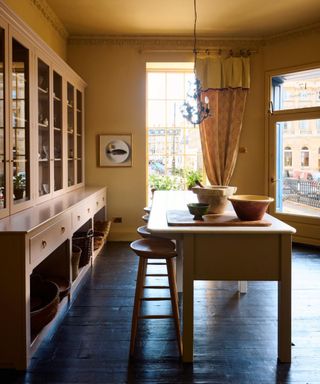
And don't always think of drapes as coming in pairs. Sometimes a single panel works best, especially if you are dressing a small window and want to maximize natural light. Plus, you can go bolder with just one drape without overwhelming the small window.
If you want to use just one panel, it's definitely worth slightly extending the curtain rod to one side so you can push the drape to one side, almost completely off the window.
9. Create a focal point by framing the window
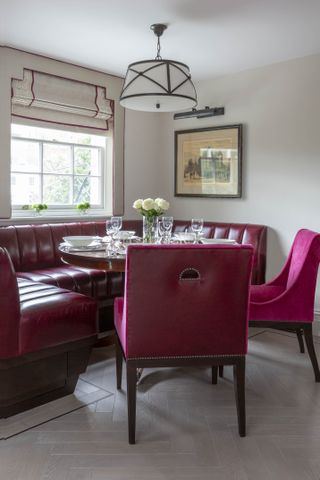
A well-framed window can anchor a room and give it a polished, cohesive look. Consider using architectural elements like cornices, pelmets, or custom-made frames to highlight the window. These elements can add a touch of sophistication and provide a finished, tailored look and are especially effective for formal living room ideas or dining room ideas, where a touch of elegance is desired.
A ‘lambrequin’ is a traditional design technique that provides a window treatment with a dramatic edge, and is a fabulous way to jazz up a window with a blind so it becomes almost architectural in style.
Interior designer, Henry Prideaux explains, ‘I am always delighted when there is an opportunity to use a lambrequin layered over a Roman blind within a suitable scheme, framing the window like a theater set to give a space structure and gravitas.'
10. Create the illusion of ceiling height
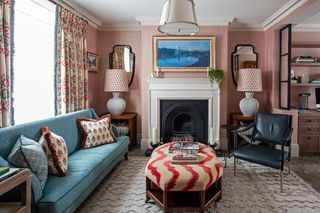
One of the biggest issues with dressing windows can be low ceilings. We’re not all blessed with stunning high-ceilinged rooms, so tricks need to be employed to create the illusion of height when hanging curtains, as Henry Prideaux shares below:
‘A trick that good designers often use – if a window is low in proportion to the ceiling height, is to position fittings as high as possible so that curtain ideas are hung above the top of the window frame to draw the eye upwards making the room feel taller and the overall effect more dramatic.'
Henry continues, 'Similarly, Roman blinds don’t necessarily have to sit immediately on top of the window. They can be fitted slightly higher and then pulled down to conceal any expanse of bare wall above the window to make the elevation appear taller allowing the window treatment to be more appropriate within the rest of the room.’
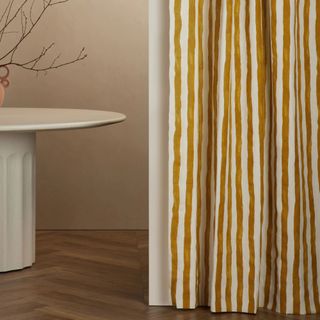
A striped window treatment is a guaranteed way to allude to height. Hang them slightly above the window frame and take them all the way down to the floor for an elegant, timeless look.
11. Pattern match with upholstery or wallpaper
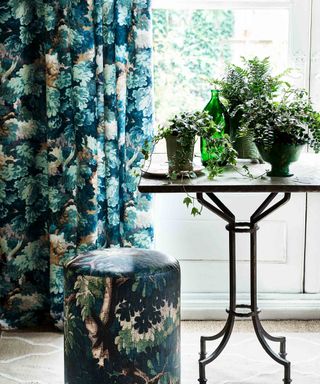
Pattern matching is a powerful tool in interior design. When done correctly, it can bring a room together beautifully and make it look professionally designed.
‘Using the same pattern on two items in a room creates cohesion, however, don’t make it too matchy matchy,’ says Ella Richards, head of design at Linwood. ‘You need to add elements of surprise – the bedroom would be rather dull without the dark blue pelmet, the footstool with its tweed-style weave, and the dash of yellow from the bedside table. It’s all about little surprises.’
‘When you already have a patterned wallpaper,’ explains Irene Gunter, founder of global interior designer studio Gunter & Co, ‘choosing a subtle fabric in a mix of soft colors that match tonally is a good way to embrace the maximalist trend in your home in a way that is a little less overwhelming.
'It’s a good idea to use blackout lining as this ensures the fabric doesn’t look overly yellow, which can happen when the light shines through.’
12. Or choose a decorative blind to add color and pattern
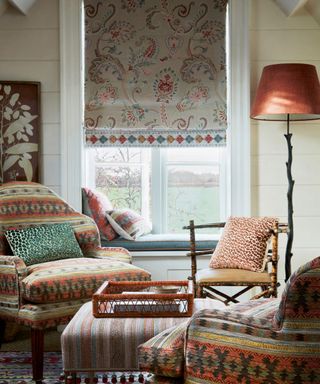
Be creative with bespoke blinds for window treatment ideas. You can bring a decorative aspect to windows by choosing fabrics that reflect and echo your soft furnishings – on your window seat ideas and beyond.
It’s also important to determine whether a style of the blind is appropriate for the window and that the scale of the design complements the other fabrics in the room.
‘I often use a sheer blind within the reveal and a more decorative design on the outer,’ says Janie Money, associate director at Sibyl Colefax & John Fowler. ‘If you use a plain material, define with a contrasting trim.’
Complementary patterns can add depth and interest without overwhelming the space. The key is to ensure the color schemes align, so the patterns feel related and harmonious.
13. Create a cocooning look by going wall-to-wall
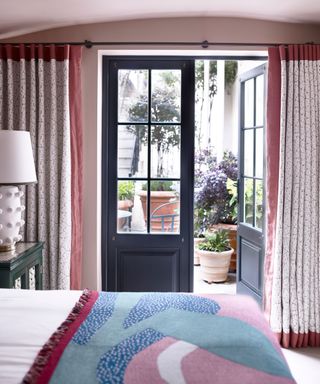
The requirements of drapes will vary from room to room, but they are all designed to provide levels of privacy, shade, soundproofing and warmth.
If you are looking for bedroom curtain ideas, think luxury. In this three-bedroom London maisonette design by Gunter & Co seen above, the bedroom has double doors which lead out onto a patio. Wall-to-wall curtains were added in front, not only to help block out light and sound when the room is occupied, but by using heavy fabric floor-to-ceiling, the curtains will also help keep out any unwanted drafts.
‘We worked with a palette of rich colors to make the most of the daylight on offer in the property, from lighter colors in light-filled spaces to warm and rich shades in darker spaces,’ says Irene Gunter, founder of Gunter & Co.
As well as these practical elements, the rich textures and deep folds of the Christopher Farr Cloth fabric in the curtains help to create a cozy atmosphere in the bedroom when drawn, a great bedroom window treatment idea.
14. Use shutters for privacy, shade – and color
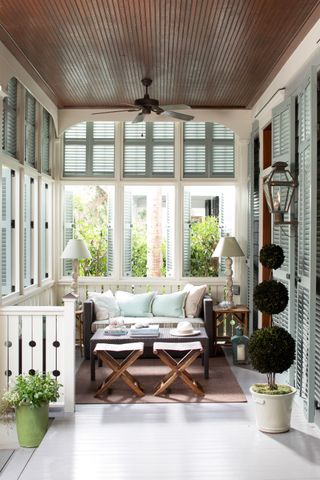
Louvered shutters like these look effortlessly elegant – and are wonderful for kitchens, bathrooms, and sunroom ideas because they can filter out noise, dirt and even the cold.
'Shutters offer a timeless appeal that can complement a variety of interior design styles,' says Sally Denyer, digital marketing manager at Shutterly Fabulous. 'When compared to curtains or blinds, shutters offer better control over the amount of light that enters a room, making them ideal for hot summer weather.
'Shutters are also a better choice than curtains for kitchen windows as they are more durable and easier to clean.'
And shutters aren't just for indoors – they are making their way outdoors, too, to create cool shade on a south-facing porch or to provide privacy on a porch that is overlooked. They are a wonderful tool for extending your indoor space outdoors – and for providing a colorful backdrop. Of course, a pale green is wonderful for linking that transitional zone to the foliage outdoors.
15. Create a seamless look on larger windows
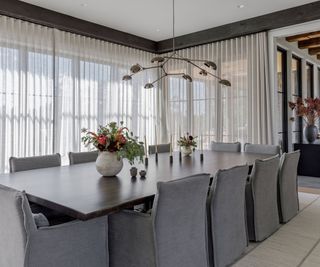
Finding the right treatments for large expanses of windows is tricky, and while going without can be a chic option, it only works if privacy isn't a problem.
You want to choose a treatment that doesn't distract from the views and doesn't block out the light too much when they aren't in use. This sheer choice from designer Becky Shea is ideal. You don't get all the visual clutter of a pair of drapes at each window, instead, a few large panels cover all the windows seamlessly, and when not in use they go almost undetected. The track is also disguised in the modern version of a pelmet that runs along the ceiling.
16. Choose full length curtains for a traditional look
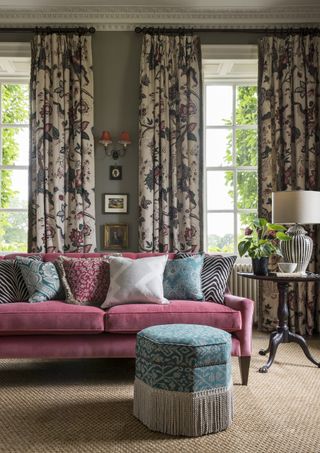
For a traditional living room consider curtains in decorative prints inspired by historic designs such as this Palampore Tree of Life design from Warner House, which draws from the exotic chintzes printed in the 17th-century on the Coromandel Coast for the European market.
‘Almost any fabric can be used as a curtain provided it has a beautiful drape. Best quality curtain lining and interlining materials give a luxurious finish, enhancing the beauty of the fabric and accentuating shape and fullness,’ says Lee Clarke, Director at Warner House.
‘We believe “more is more” and in almost every instance we would advise curtains should be full length: puddled for a traditional feel, or flush to the floor for a modern finish.'
'Be generous with your widths to avoid lackluster, thin curtains – show off color and design with sumptuous fullness,' advises Lee Clarke. 'Hang curtains above the window frame for extra height and to showcase a fabulous sweeping design. We love the pinch pleat heading: triple pinch for a heritage look, or the double pinch for a sleeker finish.'
17. Use soft blinds in the bathroom
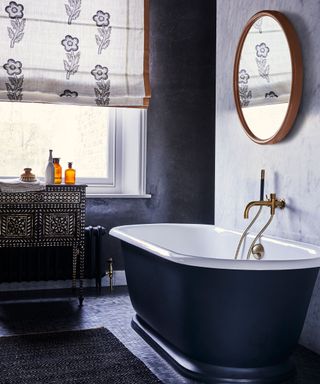
A pretty Roman blind is a sure winner when it comes to any space. Window blinds will add softness and character to a contemporary bathroom space. Here, a simple motif on the blind is reminiscent of Indian woodblocks, and chimes well with other elements of moody Eastern influence.
For bathroom window treatment ideas, and for blinds and curtains to work well, make sure your room is well-ventilated to prevent any mildew from developing. Avoid full-length designs if you can – or at least ones that hang on the floor – and opt for a lightweight fabric that will not only maintain privacy while letting in sunlight but will also dry quicker in case they do get damp.
18. Pick natural materials like linen for a relaxed appeal
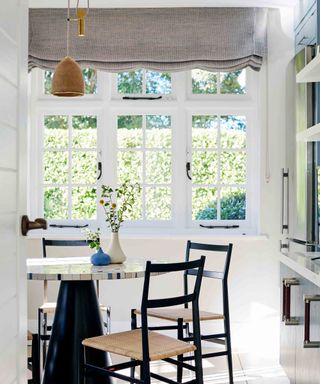
Choosing natural materials for your window treatments, such as linen, can significantly enhance the ambiance of a room, giving it a relaxed and inviting appeal. Linen, with its unique texture and organic feel, brings a touch of effortless elegance and comfort to any space.
Linen curtains provide a beautiful balance between privacy and light, they let in enough natural light to keep the space bright and airy while still offering a degree of privacy. Whereas a bedroom benefits from black-out blinds, a kitchen or dining room is great a place to welcome in the natural morning light, for more inspiration, see our kitchen window ideas.
Roman blinds, which fold up rather than roll, which aren’t too heavy work well in this breakfast area by interior designer Sophie Ashby at Studio Ashby, as they allow you to control how much light comes through.
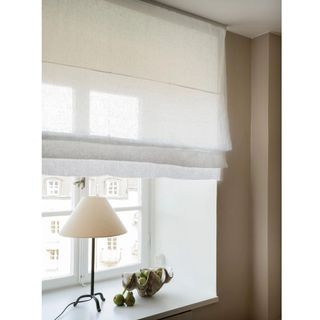
A classic that would work with any style, these sheer Roman blinds add a softness to more practically spaces like kitchens and bathrooms.
19. Try a warm shade in a cool room
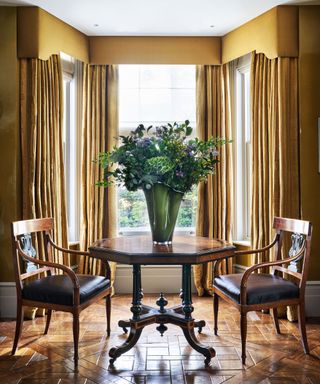
A pelmet, also known as a cornice board, is a box frame used to conceal the top of curtains, and is commonly found in classic-style interiors.
Pelmets can be made by using foam core or plywood to create a structure that can either be painted a similar tone to your walls, or upholstered in fabric to match the curtains hung beneath.
Though largely a decorative feature giving prominence to windows, they – and other window valance ideas – are also designed to help conceal and also offer additional insulation around your windows, which is why they are so popular in older buildings such as this Kensington townhouse.
Here, interior designer Christiana Syrris, then at Studio Indigo, used a bold mustard hue both on the walls and the window dressing. This technique provides a modern twist while also adding depth and interest within a singular color palette.
20. Embrace the ruffle trend with a relaxed Roman blind
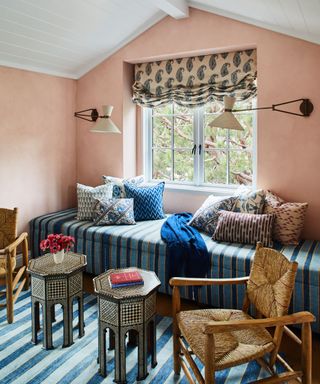
Ruffles are all the rage at the moment so why not create a nod to the look with a ruched ‘relaxed’ style fabric Roman blind?
Relaxed Roman blinds, with their gentle, informal folds, are the perfect vehicle for incorporating ruffles into your window treatments. Unlike the more structured Roman blinds, relaxed Roman blinds have a softer, more casual look that lends itself beautifully to the addition of ruffles.
‘Adding a large scale floral fabric ruched to create a ‘London’ blind with a contrast or striped trim delivers a touch of whimsy, creating a considered and joyful interior,’ adds Richard Smith, founder and creative director, Madeaux
21. Balance light and privacy with a Venetian blind
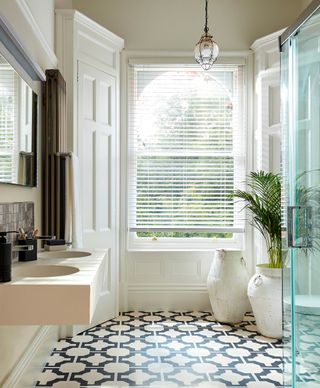
Venetian blinds have adjustable horizontal slats, also known as louvers, which allow you to control light levels whilst maintaining privacy – this makes Venetian blinds a perfect choice for bathrooms, plus, depending on the material they can be water-resistant and can be easily wiped clean which is important in moist areas.
Venetian blinds are also perfect if you are on a budget or furnishing a rental home. From outside, they give the impression of shutters – but at a much lower price. Like shutters, they do gather dust, so white or pale finishes are better for disguising this and creating bright rooms.
22. Layer with a valance to create a statement
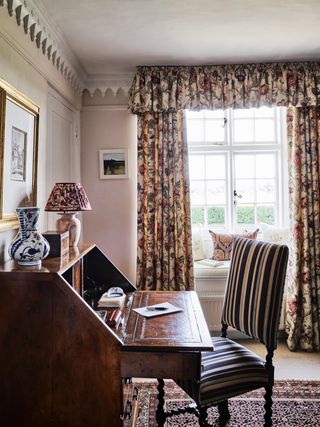
Often used for living room drape ideas in a period property, we can use the character of the original features and inspiration of the past to recreate window dressings how they used to be. In this instance, the valance complements the rest of the scheme and frames the beautiful window seat area perfectly – ideal if you are researching country curtain ideas.
Carlos Garcia, interior decorator at Carlos Garcia Interiors shares what he did: ‘I chose a valance to give softness, warmth and a touch of understated opulence to the room. The loosely hand gathered heading adds informality too and suits the beautiful Robert Kime floral linen.’
23. Pick solar shades for bright rooms

A bright room that you spend lots of time in during the day is wonderful, of course, but if you have noticed that your furnishings are suffering from fading, you might like to consider solar shades, which allow light in – unlike black-out blinds – but are made from a material whose weave blocks some of the light.
‘Solar shades now come in stylish and beautiful options, and are great investment pieces for larger spaces such as a living room,’ explains interior designer Mary Patton. ‘Preserving energy and protecting your furniture from the sun is a major plus.’
Remember that fabrics with tighter weaves will allow less light in – this means you can specify the weave to suit the amount of light control you need. And, if you can't reach the shades' mechanisms, motorized solar shades are available.
24. Tackle a corner window cleverly with curtains

If you’re lucky enough to have a beautiful corner window then dressing it correctly is key to maintaining the light and character of the space – this might be a particular issue if you are looking for cottage curtain ideas which often have to address tricky spaces. We asked Harry Cole, founder of Loom & Last how to deal with this tricky window treatment.
‘Corner windows offer a great source of light, but it can be a daunting decorating decision when dressing them. Simplify the design process by treating each window as a single unit and hang each pair of curtains on separate rods. To ensure unity within the space, position the rods at the same height to create an L shape, but remember to allow enough room between the brackets.’
25. Try on-trend vintage-inspired cafe curtains
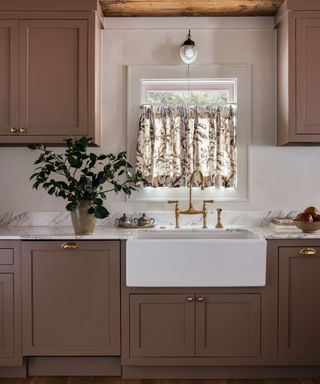
Cafe curtains are a delightful way to add vintage flair to a space while maintaining privacy and allowing natural light to filter through. They evoke a cozy, retro vibe that's perfect for kitchens and bathrooms.
You can choose fabrics, patterns, and detailing that complement your existing decor and personal taste. Designer Shannon Eddings who designed the pink kitchen seen above, chose a botanical floral print to add a touch of whimsy to an otherwise pretty utilitarian space.
Cafe curtains are easy to install and can be adjusted to fit various window sizes. They're another great option for renters or homeowners looking to refresh their space without major renovations.
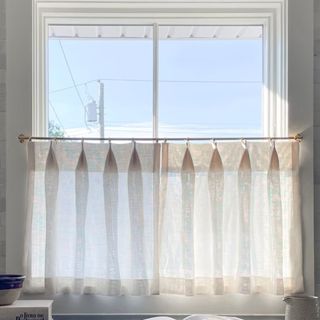
Add a rustic look to a kitchen or bathroom in an instant with cafe curtains. This sheer design will ensure you still maximize on natural light too – something to definitely consider in a bathroom that often doesn't get a lot of natural light.
FAQs
How do I measure up for window treatments?
Follow measuring instructions carefully for the specific blinds or curtains you wish to order and the situation you want to fit it into, such as a bay window or patio door or standard rectangular window. These are provided on most retailers’ websites. Use a metal measuring tape as fabric tapes can stretch or give inaccurate measurements. Also decide which side you want the controls on for convenience of use.
How do you decide whether to fit inside or outside the recess? This will depend on whether your window has a recess or not and what obstructions there are to fit the blind inside the recess, such as handles, window fittings, and the direction the window opens.
If the space is clear then it comes down to personal preference, but most people prefer to fit their blinds inside the recess and curtains are fitted outside the recess.
How do I choose a curtain header?
The main options are eyelet – usually where large, metal rings are set within the fabric at the top of the curtain and easily loop onto a curtain pole – or pleated – a more classic look where gathered folds run along the top of a curtain which can be attached to a track or a pole with hooks. There are then further variations between these looks, which all give slightly different appearances.
‘At Warner House we love the pinch pleat heading; triple pinch for a heritage look, double pinch for a sleeker finish,’ says Emma Clarke, director, Warner House. 'Be generous with your widths to avoid lackluster, thin curtains. Hang curtains above the window frame for extra height and to showcase a fabulous sweeping design.'
Once you’ve decided, you can then start to have fun choosing a curtain pole, or take a look into pelmets to cover the top of the curtain entirely.
How do I pick a pattern for my window treatments?
‘There are a range of practical and aesthetic considerations when choosing curtain fabric,’ says Emily Mould, Design Director Romo and Black Edition. ‘Consider whether you want to make a statement with a strong color, pattern or contrasting texture or whether you want a subtler look with a plain, textural neutral or muted pastel shade.
'A bold, large-scale design can create a striking focal point and will work best when used for large windows where the full repeat can be fully appreciated. If you have smaller windows, opt for a small-scale pattern to create a more refined look.
'Consider the quality of the material; an elegant lightweight sheer can gently diffuse the sunlight whilst dressing your windows with more substantial fabrics such as luxurious wools or sumptuous velvets can help prevent drafts and retain heat.
'Color is also important; pale earthy blues and greens can provide a relaxing haven whilst rich shades of plum or scarlet create an intimate space and luxuriant tones of ochre or burnt orange can induce a feeling of warmth.'
What window treatments are on trend for 2025?
xx
What is the best alternative to blinds?
x
A window treatment can make or break a room's scheme, so don't leave it until last minute to decide on which is best for your space. Use this guide to inspire what window treatment ideas will work best in your home and for further inspiration see our editors round up their favorite designs in our window treatment shopping guide.
Sign up to the Homes & Gardens newsletter
Design expertise in your inbox – from inspiring decorating ideas and beautiful celebrity homes to practical gardening advice and shopping round-ups.
With over 30 years of working in journalism on women's home and lifestyle media brands, Rhoda is an Editorial Director, Homes Content, at Future. Over time, Rhoda has worked on the entire homes and gardens portfolio including Homes & Gardens, Country Homes & Interiors, Livingetc, Ideal Home, Style at Home, Woman & Home, 25 Beautiful Homes, Amateur Gardening and Easy Gardens. She was also editor of Country Homes & Interiors for 14 years, leading it across print and creating the blog Country Days. She has also worked at Woman’s Weekly, Family Circle and Practical Parenting.
- Zara StaceyContent Editor
- Charlotte OlbyStyle & Trends Editor
- Jennifer EbertEditor
-
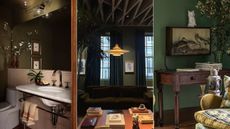 Joanna Gaines and Victoria Beckham love this gorgeous forest green color – it's a favorite with designers, decorators, and color forecasters for 2025
Joanna Gaines and Victoria Beckham love this gorgeous forest green color – it's a favorite with designers, decorators, and color forecasters for 2025Soothing, bold and rich, our love affair with this sumptuous shade is far from over
By Jennifer Ebert Published
-
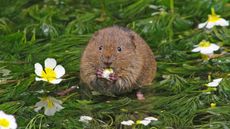 How to get rid of voles – 5 natural, eco-friendly ways to help identify, remove, and prevent these critters from damaging your plants
How to get rid of voles – 5 natural, eco-friendly ways to help identify, remove, and prevent these critters from damaging your plantsYou can keep your yard safe from voles without relying on toxic chemicals
By Lola Houlton Published
